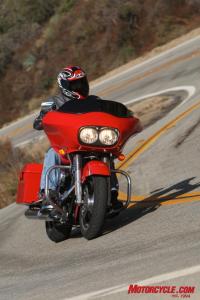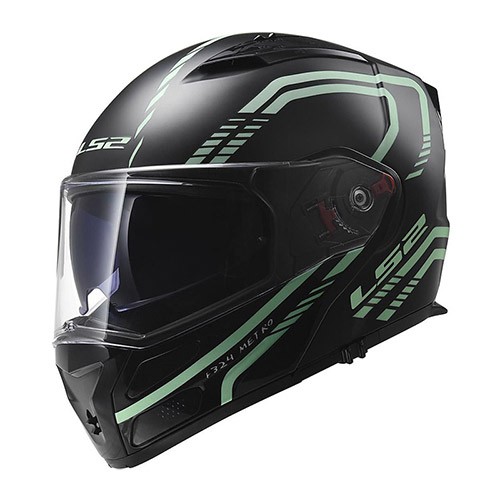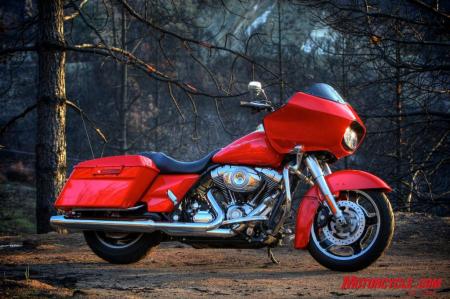And this is from God; because for the Messiah’s sake it has been granted to you not only to trust in him but also to suffer on his behalf, to fight the same battles you once saw me fight and now hear that I am still fighting. We have ridden to the mountaintop on all these motorcycles, and seen the promised land. The Victory is no longer with us, but that’s not important right now: Our eyes have seen the glory of the coming of the bagger. Hallelujah, etc…
If you’re in the market for a new bagger in 2010 you’re in luck.Victory has added not one but two new models to its touring family. The Cross Country and Cross Roads expand Victory’s own touring family while adding more selection to the collection of hardbag cruisers currently on the market.
With the new Vics comes more competition for Harley-Davidson, arguably the father of the hard luggage cruiser segment.
During the unveiling in July of this year of the two new models, Victory didn’t mince words when the company made it plainly obvious Harley’s Street Glide and Road King are where Victory had set its sights with the Cross bikes.
|
|
Most intriguing to us was the ‘Country, with its long range intentions evident in its fork-mounted fairing that houses a dash with a data-rich LCD, 12-volt power port, and cleanly integrated sound system display.
Despite Victory’s blatant targeting of the Street Glide, we thought we’d mix things up a bit, choosing instead to compare the Cross Country and its fork-mounted fairing to the H-D Road Glide that fastens its sizable fairing to the frame. Although the Road Glide and Street Glide have distinct appearances, they’re largely the same motorcycle beyond their fairings.
Is newer always better?
For some enthusiasts this comparison could come to an easy end when considering the Victory’s more powerful 106 c.i. Twin – the same mill in the Vision – which cranked out 102 ft-lbs and 85 hp when we tested it in our 2009 Luxury Touring Shootout.
Harley’s Twin Cam 96 boasts a claimed 92.6 ft-lbs, so it’s already behind the dyno curve; and when we tested the Twin Cam 96B (largely the same engine save for a counter balancer) in the Rocker C during our Mainstream Choppers Comparison, the 96 cubic-inch Harley Twin managed 80.4 ft-lbs and a modest peak horsepower reading of 61.4 ponies.
|
|
Indeed, if it were just a game of numbers the RG would suffer considerably. However, there’s as much disparity in engine character as there is dyno results.
While the Victory’s single overhead cam valvetrain configuration grants it a revvy, powerful nature, rigid mounting also transmits more vibes and buzz to the rider through the floorboards and handlebar. The big 106 also has a more mechanical sound than the H-D lump.
The Victory sits steadily at idle, while the Glide’s 45-degree Twin causes the whole bike to rumble and shudder. However, once the Glide is under way, engine power pulses smooth out considerably and rubber engine mounts mitigate excess vibes.
 Victory’s Freedom 106/6 V-Twin offers clear power advantages, however, some notable engine buzz is detectable thru floorboards and bars.
Victory’s Freedom 106/6 V-Twin offers clear power advantages, however, some notable engine buzz is detectable thru floorboards and bars.
The Harley accelerates briskly off the bottom and through mid-range; it’s not until the upper reaches of the rpm range the Victory becomes the obvious leader. Despite the Vic’s power advantage, trying to sense differences and determine a clear winner from the saddle isn’t nearly as easy as it is when looking at dyno charts.
The Cross Country’s extra punch is an undeniable boon in this market segment, but overall we prefer the Harley’s engine character.
Throttle response is good on both machines, although the Harley has a nearly undetectable hesitation from closed to open throttle. The Road Glide brings the advanced technology of throttle-by-wire along with a light throttle return spring. But in the end the Victory’s throttle gave more precise action, the feeling we were better connected to the EFI system.
Six-speed trannies in both motorcycles work well, offering positive engagement at each gearshift. And while we appreciated the Glide’s lighter effort clutch, the Vic’s clutch gave better overall feel while modulating the lever.
 Although the Road Glide’s handling isn’t quite as “sporty” and doesn’t offer as much lean angle as the Cross Country, the Glide is no slouch in the twists and turns. The updated frame from 2009 has dramatically improved handling on all Harley touring sleds.
Although the Road Glide’s handling isn’t quite as “sporty” and doesn’t offer as much lean angle as the Cross Country, the Glide is no slouch in the twists and turns. The updated frame from 2009 has dramatically improved handling on all Harley touring sleds.
We liked the heel-toe shifter as standard on the H-D, where a heel-toe shifter is available for the Cross from Victory’s parts and accessories catalog.
And it bears repeating here, as we noted in the Cross Country’s single-bike review, that the Victory’s lower controls have three available positions to fine-tune fit, and its floorboards (longest in class according to Victory) offer some upward movement. The Harley’s floorboards provide no movement when scraping through a turn, nor does the Harley have quite as much lean angle as the Victory.
“The not-so-obvious benefit here with the H-D’s brakes is less effort and better modulation, but only by the thinnest of margins.”
Braking performance is another area where rider preferences will likely make for a difficult time determining an outright winner. Each bike utilizes dual discs up front, and each bike’s calipers have sufficient stopping power.
Yet, after making repeated runs on each bike we felt the Harley’s Brembo-sourced calipers gave just slightly better sensitivity during initial bite. The not-so-obvious benefit here with the H-D’s brakes is less effort and better modulation, but only by the thinnest of margins.
The Victory’s rear brake stops the bike with just as much force as the front binders, and when used in conjunction with the front, haul the Country down from speed with authority.
|
|
A new age means new frames
When H-D graced all of its touring models with an all-new frame and swingarm in 2009 we were (and still are!) convinced it was one of the best things The Motor Company has ever done for its products.
Replacing the wallowy, hinge-in-the-middle sensation on previous Harley touring models is steering response and mid-corner manners that bolster rider confidence.
 The Cross’ sturdy and lightweight cast-aluminum frame imbues the Victory with handling that’s nothing short of impressive for a touring bagger.
The Cross’ sturdy and lightweight cast-aluminum frame imbues the Victory with handling that’s nothing short of impressive for a touring bagger.
Victory also pulled one out of the chassis hat a few years ago when it unveiled the Vision. Rather than a collection of steel tubes to hold the engine, the Vision’s backbone was a modern, beefy cast-aluminum frame with few excess parts. The Vision’s frame that seemingly draws from technology in the sportbike world offers rigidity that translates into a responsive, obedient handler.
The Cross Country uses a cast-aluminum frame similar in concept to that in the Vision, and for this reason the Cross is also an excellent steering and handling machine for a bagger with a claimed dry weight of 765 lbs (769 lbs on the Glide). Initial turn-in effort is light, and once set in the turn, the CC’s mid-corner stability shines through.
“…the Cross is also an excellent steering and handling machine for a bagger with a claimed dry weight of 765 lbs.”
Although we’re very happy with the Harley’s handling, the Cross Country offers even greater steering precision, making it feel as though nothing other than the rider’s input can make it deviate from its intended path.
Further aiding the CC’s handling and gracing it with superior ride quality is its stout 43mm inverted fork and air-adjustable mono-shock. The Victory doesn’t sacrifice a forgiving, comfy ride in exchange for sharp handling. It’s quite the opposite. Where the pair of air-adjustable shocks that make up the Harley’s rear suspension can, at times, be harsh, the Victory is much better damped without being overly soft. Overall, the Vic has a better-balanced suspension package.
|
|
Saddle up or saddle in
The phrase “sitting in rather than on” has become cliché these days in the motorcycle realm, but it’s hard to avoid using when swapping between the CC and RG.
The Victory’s sculpted saddle not only helps hold the rider in the seat, its low 26.25-inch height makes you feel like part of the motorcycle. On the other side of the ergo coin, the Road Glide’s 29.5-inch seat height generates the sense you’re perched atop. However, this shouldn’t imply an awkward or uncomfortable rider triangle on the Harley. Reach to the Harley’s handlebar is easy, as is seat to floorboard relation.
Ergos on each bike aren’t necessarily superior to the other, just different.
Something that may turn off riders of the Cross Country is the noticeable wind buffeting we experienced at freeway speeds. We suspect the taller accessory screen from Victory will result in a marked reduction in turbulence.
 As often as Pete extols the use of simple, minimal exhaust systems, he had to admit the single canister on the RG creates an unbalanced look at some angles. As good as it looks here, this photo doesn’t tell the whole story of the richness of the RG’s red paint.
As often as Pete extols the use of simple, minimal exhaust systems, he had to admit the single canister on the RG creates an unbalanced look at some angles. As good as it looks here, this photo doesn’t tell the whole story of the richness of the RG’s red paint.
The Glide is essentially liberated of any windshield, leaving only the large fairing to protect the rider from the elements. Buffeting on the RG isn’t as noticeable as on the Victory. Aboard the Harley, the rider cuts a cleaner path through the air with the tradeoff being a little more exposure to wind.
Like Victory, H-D also makes a taller screen available, but the accessory screen for the RG takes it from one extreme to the other, as it’s quite tall and on the order of a full touring shield. But if you’re okay with how it alters the RG’s appearance into a more serious-looking touring rig, we can tell you from having ridden the RG with and without the tall screen, life is good behind the big screen, especially if you don’t like the wind, rain or cold!
Not-so-little things on big bikes
Harley and Victory take different (surprise!) approaches to amenity-type things.
 Victory proudly proclaims most storage capacity of any bagger in its class. Though the Vic’s bags aren’t as voluminous as they appear from their exterior, the lid’s shape provides some unexpected storage volume. The simple one-button locking/opening mechanism is a welcome advantage over the Road Glide’s more involved lid latching process.
Victory proudly proclaims most storage capacity of any bagger in its class. Though the Vic’s bags aren’t as voluminous as they appear from their exterior, the lid’s shape provides some unexpected storage volume. The simple one-button locking/opening mechanism is a welcome advantage over the Road Glide’s more involved lid latching process.
The Victory provides a dedicated 12-volt cigarette-style power port just below the left stereo speaker; the Harley offers… a cigarette lighter in the dash! That’s OG (original gangsta), baby!
Another benefit of the Glide’s larger fairing is a pair of fairing-integrated storage compartments/gloveboxes. Each compartment’s lid is spring-loaded and within arm’s reach. However, neither is lockable, and their interior space tapers, so they’re not as roomy as you first think when seeing their large lids.
Perhaps even more noteworthy is the Glide’s ability to lock the steering head at the ignition switch. Since the Vic’s ignition is located in front of the rider’s left knee – and there doesn’t appear to be any access to the head stock – there’s no way to lock the head for an easy and cheap theft deterrent.
Both baggers have self-canceling turn signals, and both bike’s sound systems have auto-adjusting volume. The Cross Country provides a prominently displayed GPI (gear position indicator) in its dreamy blue backlit LCD; the Harley only indicates sixth gear when a tiny 6 in the lower portion of the speedo’s face illuminates green.
 From this pair of photos, the Vic’s bag’s capacity advantage is obvious. However, the Harley’s bags are deceptively roomy and of excellent quality. Bags on both bikes are removed with relative ease via Dzus fasteners.
From this pair of photos, the Vic’s bag’s capacity advantage is obvious. However, the Harley’s bags are deceptively roomy and of excellent quality. Bags on both bikes are removed with relative ease via Dzus fasteners.
Greater storage capacity hard bags grace the Country and offer the convenience of a single pushbutton locking/opening mechanism. But as we reported in our single-bike test of the Vic, you must make certain you hear the click when closing the lids to ensure they’re securely shut, even if you don’t specifically lock them. Otherwise you may have an excited motorist signaling to you that all your crap is flying down the interstate.
Naturally each bike accommodates for a passenger, and the Victory’s pillion is wider and plusher. However, the Vic’s passenger peg/boards need to be lower, or the pillion seat higher, as riders’ hips seemed to cramp relatively early while playing passenger.
Surprisingly, each scoot managed a respectable observed 38 mpg, but more impressive is that the Victory did this with a larger, more powerful engine.
Bagger battle culmination
Objective stuff like a bigger, more powerful engine and roomier, easier-to-operate saddlebags nudge the Cross Country toward the finish line tape in this bagger tête-à-tête. And its $1,000 savings over the Harley’s $18,999 base model MSRP can easily launch the Victory to, well, victory in this comparison.
But our sporting influences here at Motorcycle.com also favor the Victory’s remarkably precise and stable handling that allowed us to charge each twist and turn with the confidence the bike could handle our attempts at ever-increasing corner entry speed.
And for this reason we think the aging sport rider who’s begrudgingly looking to cruisers as a way to stay on two wheels after parking the supersports might embrace the Cross Country as touring cruiser for speed junkies.
|
|
We like how Victory threw in something as practical as cruise control as standard equipment on a touring bike, where H-D requests an additional $295.
Although also an option ($845), at least ABS is available on the Road Glide. And it’s this one area where we think Victory really took a misstep by not offering ABS on the Cross Country.
Even if the anti-lock option might’ve closed the pricing gap ‘tween the bikes, its availability could’ve meant all that many more consumers to whom ABS is now crucial in their purchase decision-making. Victory points to their own research that indicates customers in this segment aren’t concerned with linked braking or ABS. But like a good salesman will tell you, sometimes you’ve got to tell the consumer what they need.
Whether or not riders like it, we’re reasonably confident mandatory ABS on motorcycles is on its way, sooner than later. (End helpful rant.)
|
|
Hopefully, through all this, we’ve made it apparent that the Road Glide is still– in almost every department – a formidable opponent for the stylish, brawny new guy in the bagger class, and that so much about a decision between these steeds could very well come down to rider preferences.
But for now, for us, the Victory’s got it!
Related Reading
2010 Victory Cross Country Review
2010 Harley-Davidson Road Glide Custom Review
2010 Victory Models Line-up Preview
2010 Harley-Davidson CVO Models Review
All Things Harley-Davidson on Motorcycle.com
All Things Victory on Motorcycle.com


 2010 Victory Cross Country.
2010 Victory Cross Country. 2010 Harley-Davidson Road Glide.
2010 Harley-Davidson Road Glide. A big bike that boogies!
A big bike that boogies! The Road Glide uses an array of analog dials for not only speed and rpm, but also for ambient air temp and oil pressure. A small LCD in the speedo provides mileage totals as well as a miles-remaining-until-empty counter. A single-disc CD player is part of the Harman/Kardon audio package.
The Road Glide uses an array of analog dials for not only speed and rpm, but also for ambient air temp and oil pressure. A small LCD in the speedo provides mileage totals as well as a miles-remaining-until-empty counter. A single-disc CD player is part of the Harman/Kardon audio package. Depending on your needs or wants, either bike is an excellent choice.
Depending on your needs or wants, either bike is an excellent choice. Despite a clear advantage in the engine room and an advanced design frame, the Victory doesn’t necessarily blow the ol’ dog Road Glide off the map, as the Harley still has a lot to offer prospective buyers. However, along with the more powerful Twin, better handling and a few other assets, we had the Cross Country just edging out the Harley when considering the Victory’s $1K savings in MSRP.
Despite a clear advantage in the engine room and an advanced design frame, the Victory doesn’t necessarily blow the ol’ dog Road Glide off the map, as the Harley still has a lot to offer prospective buyers. However, along with the more powerful Twin, better handling and a few other assets, we had the Cross Country just edging out the Harley when considering the Victory’s $1K savings in MSRP.